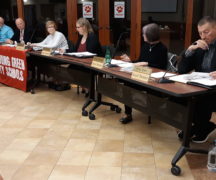By JAN LARSON McLAUGHLIN
BG Independent News
Bowling Green Board of Education voted unanimously Tuesday to spend an estimated $750,000 to put turf down in the athletic stadium.
Repeatedly denied new school buildings by voters, the board decided to use pipeline tax revenue to give students the athletic facilities already offered at other schools.
“On behalf of all the coaches and athletes, thank you for the support,” Superintendent Francis Scruci said after the vote. If all goes as planned, the turf will be in place for this fall’s football season.
Getting unanimous support was a hard-fought touchdown, with one board member, Tracy Hovest questioning the priorities of the district.
“The teaching and learning facilities that directly impact every child are inferior,” Hovest said, pointing out air conditioning and electrical deficiencies of the school buildings. “We just stayed closed for nearly a year because of ventilation and space issues.”
Hovest did not question if Bowling Green athletes deserved turf, but insisted that all students deserve better learning facilities, she said.
“Turf is just not at the top of my priority list,” she said, noting that she had not heard about the turf proposal until Tuesday’s meeting.
But the other board members said it’s not a matter of improving the athletic facilities or the academic facilities.
“We are committed to improving all facilities,” board President Norm Geer said.
Scruci pointed out the Performing Arts Center, where Tuesday’s board meeting was held.
“We provided our performing arts students a great facility,” he said, suggesting that student athletes deserve the same.
The turf would be placed on the football field – which would then be used for football, soccer and lacrosse. The current facilities are “sub-par,” Scruci said, preventing the district from hosting any tournament games.
For Friday night football games, it’s embarrassing when buses roll up with visiting teams already in their uniforms because they don’t want to use Bowling Green’s locker rooms, he said.
“We can’t just continue to turn a blind eye,” Scruci said.
“Our academic facilities need a lot of love and care,” he agreed. But the 500 or so athletes deserve decent facilities, he said. “We owe it to our community and our students.”
Before COVID hit, a group of citizens was preparing for a community campaign to raise money for a field house. If the district went ahead with the turf, then the citizens group could move forward with its efforts, Scruci said.
Athletic Director Dirk Conner said Bowling Green is one of only two districts in the NLL to not have a turf field.
Geer, who has a grandchild on a soccer team, said the grass soccer field is uneven and has no lights, so games often go unfinished when it gets dark.
“Our field is by far the worst,” he said. “It’s embarrassing to go to all these other schools and compare it to what we have.”
Geer said he is surprised that the district hasn’t been charged with a Title IX infraction for not providing equal facilities for girls.
“We owe it to the kids,” he said.
Scruci agreed.
“We need to give our kids the opportunities that our neighboring districts do,” Scruci said.
By using the Rover pipeline revenue, the district can do something positive for students.
“I think the time to act is now,” Geer said.
But Hovest questioned where the plan is for improving school buildings, and expressed concern about the perception of putting sports over scholastics.
“I would like to put our classrooms first,” she said.
Board member Jill Carr said the board remains committed to improving the district’s buildings.
“We have never stopped talking about facilities and what needs to be done,” she said. “We’re not putting one thing over another.”
The new turf, Carr said, will be a boost for students.
“Let’s do something positive after so much negative,” she said.
Board member Ginny Stewart said the installation of turf will help the community, by bringing tournaments to the city. The facilities could be a source of pride for students, she said.
And board member Ryan Myers said the board can address both academics and athletics.
Scruci said even though voters have repeatedly rejected new school buildings, the pipeline revenue can allow the district to make some improvements.
“We should start chipping away at things,” he said. “Or we’re going to continue to be behind everybody else.”
Scruci brushed aside concerns about potential criticism.
“We will get criticized for anything we do,” he said. “You as a board have always done what is right for kids. I’ve got two more years in this district, but I’m not going to lie down. I’m going to fight for our kids.”
If Bowling Green City Schools doesn’t start making some facility improvements, people will not want to move to the district, Scruci said.
“If we don’t have something to offer, they aren’t coming,” he said. “Right now, that’s why we’re losing people to the north.”
As for school buildings, Scruci said meetings must start again with teachers and community focus groups. “We need to get this community on board,” he said.
In the meantime, the pipeline revenue may also be used to replace the boilers at Conneaut and Kenwood elementaries for an estimated $100,000 each. Conneaut classes are all being conducted remotely on Wednesday because that boiler is not functioning, Scruci said.
Geer predicted 2021 will be a busy year for BG City Schools.
“We have operations needs, facilities needs and funding needs,” he said.
But COVID funding, possible infrastructure funding, pipeline revenue, and passage of two continuing levies last year may give the district some opportunities for progress that it hasn’t experienced recently, Geer said.





